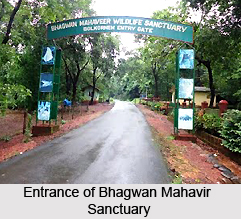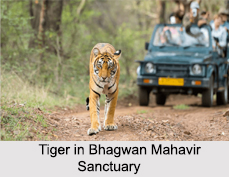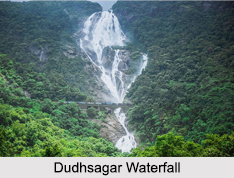 Set amidst the foothills of the Western Ghats and covering an impressive 240 sq. km the Bhagwan Mahavir Wildlife Sanctuary holds the title of the largest wildlife preserve within the state of Goa. This sanctuary is home to a huge variety of plant, bird and animal life. Nature lovers and hikers enjoy the hiking trails that traverse this huge tract of land. In addition to the large amount of biodiversity that the sanctuary possesses, it is also home to the famous Dudhsagar waterfall, the Devil"s Canyon, the Tambdi Surla temple, the Tambdi falls and a number of other historic and religious sites.
Set amidst the foothills of the Western Ghats and covering an impressive 240 sq. km the Bhagwan Mahavir Wildlife Sanctuary holds the title of the largest wildlife preserve within the state of Goa. This sanctuary is home to a huge variety of plant, bird and animal life. Nature lovers and hikers enjoy the hiking trails that traverse this huge tract of land. In addition to the large amount of biodiversity that the sanctuary possesses, it is also home to the famous Dudhsagar waterfall, the Devil"s Canyon, the Tambdi Surla temple, the Tambdi falls and a number of other historic and religious sites.
Location of Bhagwan Mahavir Sanctuary
Located amidst the dense forests, it is one of the biggest biodiversity of India. The sanctuary is situated on the eastern border of Goa, with Karnataka 53 kilometers away from Panaji and 54 kilometers away from Margao. Along with deciduous trees the forest has wide variety of shrubs and wild bushes which supports other lives in the sanctuary. Bhagwan Mahavir Sanctuary is also known for Molem National Park which is located at the centre of the sanctuary.
History of Bhagwan Mahavir Sanctuary
Bhagwan Mahavir Wildlife Sanctuary resides in South Goa and was built to protect the enriched wildlife around the Western Ghats. Earlier, it was referred to as the Mollem Game Sanctuary but got its title of being a wildlife sanctuary by the authorities in Goa in the year 1969. It was renamed to Bhagwan Mahavir Wildlife Sanctuary in the same year.
The core of the sanctuary with a rich diversity of flora and fauna was declared as a national park in the year 1978. The area comprises a total of 107 square kilometers of the entire sanctuary and is popularly known as the Mollem National Park. Now, it attracts several tourists due to its safari expeditions.
Flora of Bhagwan Mahavir Sanctuary
This sanctuary contains pristine vegetation classified as West Coast tropical evergreen forests, West Coast semi-evergreen forests and moist deciduous forests. The evergreen forests are mainly seen at higher altitudes and along the river banks. The predominant species are Terminalia, Lagerstroemia, Xylia and Dalbergia. The forest canopy is almost closed and the availability of grass is limited. There are several perennial water sources in the sanctuary and the availability of water is not a limiting factor for wildlife. In fact, one of the tallest waterfalls called the Dudhsagar waterfall, elevated at a height of 107 feet lie within the sanctuary and attracts many avian fauna that sustain on water.
Bhagwan Mahaveer National Park and surrounding area harbors 722 species of flowering plants in wild belonging to 492 genera and 122 families. 128 species of endemic plants either endemic to Western Ghats, Peninsular India or India occur in the National Park. Two recently described taxa viz. Glyphochloa veldkampii, M. A. Fonseca et Janarth and Amorphophallus commutatus (Schott) Engl. var. anmodensis Sivad and Jaleel are strictly restricted to the National Park. Additionally 37 species of Pteridophytes are also found in the National Park.
Fauna of Bhagwan Mahavir Sanctuary
Bhagwan Mahavir Sanctuary includes huge variety of wild animals among which the types of deers and gaurs, Malayan giant squirrels, clusters of monkeys and slithering Cobras and python are commonly found. Surrounded with dense forests and large evergreen trees the national park also includes the wild panthers, tigers and elephants which reside in these forests. The sanctuary is the natural habitat of several species of herbivorous animals including the Deer, sambar, spotted deer, hog, mouse deer and barking deer. The carnivores that make their home here are the tiger, leopard cat, panther, jungle cat and toddy cat.
 In addition to these, there are also lesser Indian civet, wild dog, hyena, sloth bear, jackal, bonnet macaque, slender lorris, scaly ant eater, giant squirrel, flying squirrel, flying fox and common otter present in the sanctuary.
In addition to these, there are also lesser Indian civet, wild dog, hyena, sloth bear, jackal, bonnet macaque, slender lorris, scaly ant eater, giant squirrel, flying squirrel, flying fox and common otter present in the sanctuary.
The state bird of Goa, Ruby-throated Yellow Bulbul, is the most common of the 120 species of bird that have been spotted in this sanctuary. Ornithological enthusiasts can also keep their eyes peeled for the Golden Oriole, Emerald Dove, Common Grey Hornbill, Paradise Flycatcher, Great Pied Hornbill, Malabar Pied Hornbill, Malabar Trogan, Crested Serpent Eagle, Crested Honey Buzzard, White-rumped Spine Tail, Ashy Wood Swallow, Asian Palm Swift, Jungle Babbler, Olive-backed Pipit, Pompadour Pigeon, Jungle Owlet, White-bellied Woodpecker, Black-crested Bulbul, Forest Wagtail, Scarlet Minivet, Chestnut-bellied Nuthatch, Velvet-fronted Nuthatch and the Sulphur-bellied Warbler.
The butterflies that populate the park with their fleeting flashes of colour include Blue Mormon, common Jezebel, common Mormon, common mime, plum Judy, common wanderer, crimson rose, lime butterfly, plain tiger, southern birdwing and tailed jay. There are also endemic species that the enthusiastic Lepidopterist will also notice like the Malabar tree nymph and the Tamil Yoeman.
A number of snakes are also found within the park. These include the bronze-back tree snake, cat snake, hump-nosed pit viper, Indian rock python, Malabar pit viper, rat snake, Russell`s viper, Indian cobra and common krait. The most famous reptilian inhabitant of the park, however, is undoubtedly the king cobra.
Other Tourist Attractions
Bhagwan Mahavir sanctuary is also distinguished by a number of other popular attractions. Those are mentioned below:
Dudhsagar waterfalls: This is the tallest waterfall in India and an extremely awe-inspiring natural wonder; especially during the monsoon season. Due to the milk-like appearance of the falls, they got the name "Dushsagar," which means "Sea of Milk".
Tambdi Falls: Although this waterfall is almost as high as the Dudhsagar falls, it does not attract as many visitors, due to the steep and rocky trail that one must take to approach the base of the waterfall. Hiking enthusiasts and rock-climbing fans will enjoy making this trek with one of the experienced guides that the park has to offer.
 Devil"s Canyon: Colloquially referred to as the "Devcharacho Kond," this beatific ravine is a part of the sanctuary, and now attracts many tourists due to the myth and legend created around it. The canyon is split into two by a massive rock forming a mesmerizing view for the tourists. There have been several carnivorous creatures spotted in this area like leopards and black panthers. This eerie canyon carved out of solid rock by the path of the river is notable not just for its natural peace and beauty but also for the myth and legend that surround it.
Devil"s Canyon: Colloquially referred to as the "Devcharacho Kond," this beatific ravine is a part of the sanctuary, and now attracts many tourists due to the myth and legend created around it. The canyon is split into two by a massive rock forming a mesmerizing view for the tourists. There have been several carnivorous creatures spotted in this area like leopards and black panthers. This eerie canyon carved out of solid rock by the path of the river is notable not just for its natural peace and beauty but also for the myth and legend that surround it.
Tambdi Surla Temple: Tambdi Surla Temple withstood the test of time after its construction in the 12th century. It is dedicated to the Hindu Lord Shiva, also called Lord Mahadev. This dainty temple is located in the northern region of the wildlife sanctuary. The temple is often visited for its picturesque architectural styles, including the Ashokan styled lotus carved on pillars and walls.
Cotiago Wildlife Sanctuary: It is not only the second largest sanctuary in Goa, after Bhagwan Mahavir Wildlife Sanctuary but also the oldest of the sanctuaries and was established in 1968. It inhabits a vast range of biodiversity of flora and fauna within its periphery including gazelles, sloth bears, vipers, four-horned antelopes and golden-black gliding snakes.
Eco-tourism Wing: For those anxious to learn more about the native flora and fauna, the eco-tourism wing and Nature Interpretation Centre has an invaluable amount of data and collectibles that are open to the public.
Visiting Information
The most frequented during the tourist season from October to March, it is a great place to visit during the monsoons. The sanctuary is open all days of the week. Panaji is located at a distance of 70 km from the Bhagwan Mahavir Wildlife Sanctuary. This distance can easily be covered via hired cars or taxis. Buses from the Panaji Bus Stand to the Kullem district are also available. The Dabolim Goa International Airport is 65 – 70 km away from Bhagwan Mahavir Wildlife Sanctuary. The road connectivity between Mollem, a town about 6 km from the sanctuary, and the airport is excellent and can be covered via hired taxis or rented cars. The National Highway NH-4A divides the Bhagwan Mahaveer sanctuary in two parts. Regular buses of the Kadamba Transport Corporation ply from Kadama bus station, Panaji, (53 km) to the sanctuary.



















